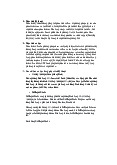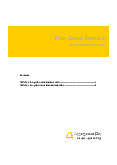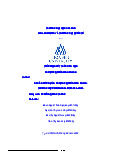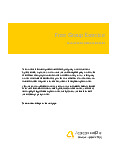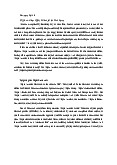





Preview text:
UNILEVER About Unilever
The environment for Fast Moving Consumer Goods (FMCG) is rapidly changing. The growing
popularity of incremental innovation appears to be based on the advantages of brand
leveraging. Customers are becoming more critical about attaching themselves to a certain
brand, therefore FMCG producers invest in R&D to come up with the greatest product that
satisfies them. Due to the current economic climate, they will also prefer to purchase less-priced products.
Unilever is a major player in the Fast Moving Consumer Goods (FMCG) industry. Unilever is a
British-Dutch multinational consumer goods corporation that was established in 1929 when the
British soap-maker Lever Brothers and the Dutch margarine manufacturer Margarine Unie
merged. Unilever offers around 400 brands in popular consumer categories such as food,
personal care, laundry chemicals, household hygiene goods, and so on. OMO, Surf, Dove,
Knorr, Comfort, Lipton… are some of the company’s most well-known brands. Unilever is a
publicly-traded firm with two subsidiaries: Unilever Plc in London and Unilever NV in Rotterdam.
It employs about 148,000 staff in over 190 nations in 2022. The firm is ranked 7th among
Europe’s most valuable companies. With a wide range of products and the Unilever brand
outperforming its competitors, it is a brand that customers trust and choose as their first choice
since it consistently provides them with a high level of happiness with each product. Unilever is
continually aware of market trends and client desires and invests a significant amount of time
and money in R&D to assure product and brand innovation.
Unilever offers a sustainable business model and, unique, clear selling propositions with a
dedication to supplying people throughout the world with products that are visually appealing
and provide a sense of belonging. When it comes to FMCGs, customers have a strong opinion.
Unilever’s mission statement is similarly quite short with the obvious goal of making everyday
life more sustainable, implying that their flagship strategy will produce long-term corporate
growth and brand value. The firm’s purpose is to help customers live longer by providing all of
their essential daily necessities, such as sanitary nourishment and personal and family health care. Reference: 1. https://www
.unilever.com/our-company/at-a-glance/ 2. https://www
.academia.edu/5617567/Pestel_Analysis_A_report_on_unilever 3. https://www .swotandpestle.com/u [ CIT ATION SWO22 \l 1033 ] n ilever/
4. https://golden.com/wiki/Unilever-Y8ZY9
Phase 1: Opportunity Identification 3. Macro Environment PESTLE analysis
As a firm with strong international relationships, Unilever must adhere to a variety of rules. They
have customers all around the world and must develop products to meet their needs, even
when demand is dropping due to global economic woes.
This PESTEL report analyses the company’s intricacies including the numerous external elements that ii faces
Unilever operates primarily in the following divisions: Beauty & Personal
Care, Food & Beverage, Home Care, and Water Purifiers, with a large
product portfolio. FMCG accounts for the majority of its revenue. As a
result, Unilever must follow the Food and Drug Administration’s requirements.
In addition, in each country where its products are distributed, the
company is also responsible for all local and regional laws, and any POLITICAL
global rules in place, including Corruption – particular at the level of
regulation in the Consumer Goods sector, Government intervention in
the Personal Products industry, Intellectual property rights protection,
Pricing Regulations – Is there a system for adjusting prices for
consumable? Taxes – tax rates (20% in Vietnam) and incentives,
Consumer Goods Industry Safety Regulations, Product Labeling and
Other Personal Product Requirements. ECONOMIC
For a firm like Unilever, which is mostly in the FMCG industry, the status of the economy is critical.
The market environment for Unilever is getting increasingly competitive,
particularly in Western Europe. In the European market, Procter &
Gamble (P&G) is a key rival. Moreover, the EU’s free trade policy has
resulted in a plethora of discounters on the European market.
Unilever’s earnings potential has been harmed as a result of this.
Retailers are putting pressure on FMCG manufactures to lower their pricing.
Following the economic crisis caused bt the Covid-19 pandemic, soicla
isolation, difficulties in producing and transporting fast-moving
consumer goods had a significant impact on Unilever’s revenue, and
consumer demand fell rapidly. High inflation makes it harder to
consume backlogged commodities as a result of economic problems.
Furthermore, because of the ongoing global economic crisis
engendered by the Ukraine war, the price of gasoline has risen to its
highest level in history, severely affecting the transportation of goods
from the point of production to the point of consumption. This is a huge
expense because the FMCG industry requires daily transportation,
resulting in a loss of revenue for the company.
Rising wages in developing countries, on the other hand, allow Unilever
to benefit more from increased potential sales because consumers
have more disposable cash. However, because the corporation has
multiple production plants in emerging countries, the same external
issue is posing an increasing cost threat. Unilever, on either hand,
should expect business growth as these countries’ consumer goods
markets develop in size and value. The Vietnamese market, for
example, provides excellent prospects for the organization to expand.
Furthermore, the develop country’s economic stability aids enterprises
in avoiding risks in other markets while fostering modest but consistent expansion. SOCIAL
Unilever has decided to focus on building a solid image despite having
so many brands. They place a strong emphasis on social and environmental issues.
Unilever’s many personal care and well-being products illustrate the
company’s strong ambition to make people feel more comfortable and
beautiful, and to live the life they deserve. Even their marketing,
particularly with Dove, is geared around making women feel their best
from the inside out, allowing them to express themselves anyway they
choose (especially in Asia, where women are stereotyped by archaic social norms).
Customers are paying more attention to health supplements, green,
and clean items as consumption trends in Vietnam change. Unilever
can expand with items that directly meet the increased interest in health
products among customers. In addition, adopting environmental
policies allows the company to attract more customers by lowering its
environmental effect. Unilever, for example, can cut its energy
consumption by using new, more energy-efficient technologies. And the
company can expand through increased sales based on increased
female consumer affluence around the world.
Unilever creates new items on a regular basis and sells them online
through its many brands. The organization is putting a lot of effort into
improving its digital sales and marketing tactics.
Unilever also has a higher level of automation than its competitors,
enabling for faster product delivery to shop locations. Otherwise, they
risk losing money, profits, or the reputation they have spent so much
time and money building. Unilever’s operational efficiency can be TECHNOLOGICA
improved by increasing business automation. New business processing L
equipment, for example, can improve inventory monitoring and support
supply and distribution chains more effectively. The same technology
externality, on the other hand, is a danger since it raises the
competitiveness of the businesses, even small businesses in the local
market. Increased research & development (R&D) spending, on the
other hand, pose a danger to Unilever because it improves the
competitive advantages of other consumer products businesses. ENVIRONMENTAL
Unilever may use the increased interest in business environmentalism
to better its environmental programs and appeal to environmentally
conscientious consumers. The company may strengthen its
sustainability efforts as a consequence of this collaboration, increasing
its competitiveness against other consumer goods companies.
Unilever’s social responsibility plan must ensure that these programs
are properly implemented across the firm.
To further limit the influencer on the business environment, the plan
should consider product innovation and internal business procedures,
for example. Unilever’s ability to respond to more complicated
environmental programs will be aided by these efforts. Such as external
issue provides the company with an opportunity to improve its
competitive advantage through corporate responsibility.
Indeed, Unilever has succeeded in portraying itself as an
environmentally conscious firm that can also keep its promises. To
improve its image and business, Unilever is working toward the United
Nation Sustainable Development Goals.
Unilever is bound by a slew of laws and regulations as a consumer
goods firm. They possess over 400 trademarks in the food, health, and
personal care industries, among others. Copyright, product safety,
employee health and safety rules, and taxes apply to each brand and
store location, both globally and regionally.
By integrating its corporate social responsibility plan with environmental
restrictions, Unilever has the opportunity to improve its business image. LEGAL
Additionally, enhancing international patent can help companies
flourish. For example, the new patent law in Vietnam aids Unilever in
reducing patent-related issues in its macro and remote environments.
Further, stricter consumer rights legislation gives the corporation the
option to improve both customer service and product quality standards.
Unilever’s brands may become more appealing in the consumer
products sector in terms of these initiatives. Reference: 1. http://panmore.com/un [ CIT
ATION Nat17 \l 1033 ] i lever-pestel-pestle-analysis- recommendations 2. https://www .mbaskool.com/p [ CIT ATION MBA19 \l 1033 ] e stle-
analysis/companies/17992-unilever.html 3. http://fernfortuniversity
.com/term-papers/pestel/nyse4/874-unilever-plc.php
Phase 2: Concept Generation
1. Bamboo charcoal cream for people with diabetes
People with diabetes are always concerned with calculating the amount of sugar and
carbohydrates they consume each day in order to maintain a healthy balance, and sweet
desserts are a rare treat for them. A single serving of vanilla ice cream has roughly 30
grams of carbohydrates which is far too much for persons with diabetes to eat.
Customers can get diabetic sugar and minimal carbs from bamboo charcoal ice cream.
Bamboo charcoal has a purifying and detoxifying impact on the body, which aids in the
elimination of excess dietary residues.
2. Lipton detox tea
The use of detox beverages made from nutritious juices is becoming increasingly
popular around the world. With antioxidant-rich licorice, nutritious fruit ingredients, herbs,
and a range of antioxidant active substances such as flavonoids, catechins, HCA
(Hydroxycitric Acid) vitamins, and minerals. Reference:
[ CITATION Glo22 \l 1033 ] [ CITATION Ali1 \l 1033 ] Bibliography
Global, U. (2022). Unilever at a glance. Retrieved from h琀琀ps://www.unilever.com/our- company/at-a-glance/ Almeida, A. R. (n.d.). . Retrie Academia ved from
h琀琀ps://www.academia.edu/5617567/Pestel_Analysis_A_report_on_unilever
Almeida, A. R. (n.d.). Academia. Retrieved from
h琀琀ps://www.academia.edu/5617567/Pestel_Analysis_A_report_on_unilever
PESTLE.com, S. &. (2022, 6 11). Unilever SWOT 7 PESTLE Analysis . Retrieved from
h琀琀ps://www.swotandpestle.com/unilever/
Smithson, N. (2017, 2 21). Unilever's PESTLE/PESTLE Analysis & Recommenda琀椀ons . Retrieved
from h琀琀p://panmore.com/unilever-pestel-pestle-analysis-recommenda琀椀ons
Team, M. S. (2019, 11 10). Unilever PESTLE Analysis. Retrieved from
h琀琀ps://www.mbaskool.com/pestle-analysis/companies/17992-unilever.html
